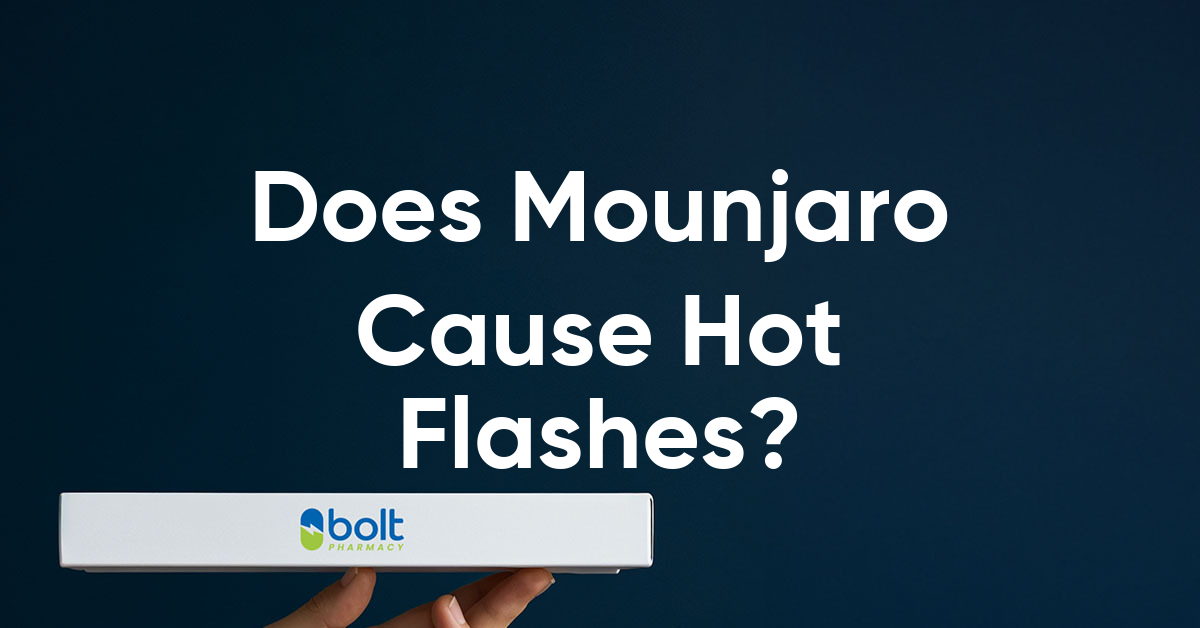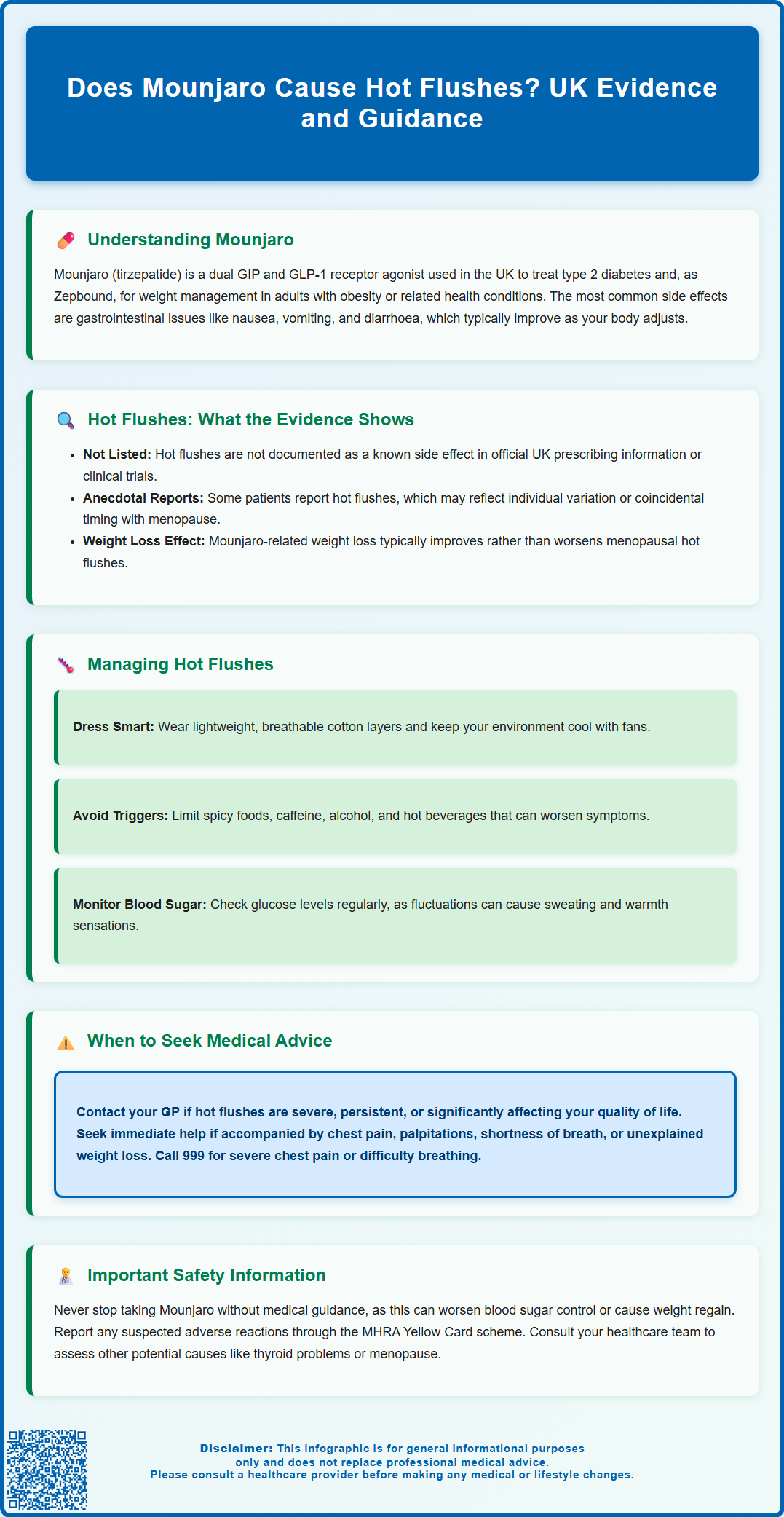
Does Mounjaro cause hot flushes? This is a question some patients taking tirzepatide have raised, particularly when experiencing new or unexplained symptoms during treatment. Mounjaro (tirzepatide) is a dual GIP and GLP-1 receptor agonist licensed in the UK for type 2 diabetes and, as Zepbound, for weight management. Whilst hot flushes are not listed as a recognised side effect in UK prescribing information, understanding the relationship between this medication and vasomotor symptoms is important for patients and clinicians. This article examines the evidence, explores possible explanations, and provides practical guidance on managing hot flushes whilst taking Mounjaro.
Summary: Hot flushes are not listed as a recognised side effect of Mounjaro (tirzepatide) in UK prescribing information or clinical trial data.
Mounjaro (tirzepatide) is a prescription medication licensed in the UK for the treatment of type 2 diabetes mellitus. In the UK, tirzepatide is also available under the brand name Zepbound for weight management in adults with obesity or overweight with weight-related comorbidities. It belongs to a novel class of medicines known as dual glucose-dependent insulinotropic polypeptide (GIP) and glucagon-like peptide-1 (GLP-1) receptor agonists. By mimicking the action of these naturally occurring incretin hormones, Mounjaro enhances insulin secretion when blood glucose levels are elevated, suppresses glucagon release, slows gastric emptying, and reduces appetite—mechanisms that collectively improve glycaemic control and promote weight loss.
As with all medications, Mounjaro is associated with a range of potential side effects. The most commonly reported adverse effects include gastrointestinal symptoms such as nausea, vomiting, diarrhoea, constipation, abdominal pain, and decreased appetite. These effects are typically mild to moderate in severity and often diminish over time as the body adjusts to the medication. Other recognised side effects include injection site reactions, fatigue, and dyspepsia. Hypoglycaemia may occur, particularly when Mounjaro is used in combination with insulin or sulfonylureas; dose reductions of these medications may be required to reduce this risk.
Important safety warnings include the risk of pancreatitis (seek urgent medical attention for severe, persistent abdominal pain, with or without vomiting), gallbladder disease, and dehydration leading to acute kidney injury with prolonged vomiting or diarrhoea.
It is important for patients and healthcare professionals to be aware of the full spectrum of potential adverse effects to ensure appropriate monitoring and management. The Medicines and Healthcare products Regulatory Agency (MHRA) and the European Medicines Agency (EMA) provide comprehensive safety information in the Summary of Product Characteristics (SmPC). Suspected adverse reactions should be reported via the MHRA Yellow Card scheme (yellowcard.mhra.gov.uk or the Yellow Card app).

Hot flushes (also called hot flashes)—are sudden sensations of intense warmth, typically affecting the face, neck, and chest, often accompanied by sweating and sometimes followed by chills. They are most commonly associated with hormonal changes, particularly the decline in oestrogen levels during the menopausal transition in women, but can also occur in men undergoing androgen deprivation therapy or due to other medical conditions.
Currently, hot flushes are not listed among the common, uncommon, or rare adverse effects in the UK SmPC for Mounjaro or Zepbound. The pivotal clinical trials evaluating tirzepatide for type 2 diabetes (SURPASS programme) and obesity (SURMOUNT programme) did not identify hot flushes as a significant treatment-emergent adverse event. However, it is important to recognise that clinical trials may not capture every possible side effect, particularly those that are rare or occur in specific subpopulations.
That said, some patients taking Mounjaro have anecdotally reported experiencing hot flushes or flushing sensations. These reports may reflect individual variation in drug response, coincidental timing with other life events (such as menopause), or indirect effects related to metabolic changes. While significant weight loss can influence various physiological processes, it's worth noting that in menopausal women, weight loss often improves rather than worsens vasomotor symptoms.
It is also worth considering that symptoms resembling hot flushes could be related to other factors, such as fluctuations in blood glucose levels, anxiety, dietary changes, or concurrent medications. A thorough clinical assessment is essential to determine the underlying cause of any new or worsening symptoms during treatment with Mounjaro.
If you experience hot flushes while taking Mounjaro, there are several practical strategies that may help alleviate symptoms and improve your comfort. Lifestyle modifications are often helpful and include:
Wearing lightweight, breathable clothing made from natural fibres such as cotton, and dressing in layers that can be easily removed
Keeping your environment cool by using fans, opening windows, or adjusting air conditioning
Avoiding known triggers such as spicy foods, caffeine, alcohol, and hot beverages
Maintaining a healthy weight and engaging in regular physical activity, which can help regulate body temperature and improve overall wellbeing
Practising stress-reduction techniques such as mindfulness, yoga, or deep breathing exercises, as stress and anxiety can exacerbate vasomotor symptoms
It is also important to monitor your blood glucose levels regularly, as recommended by your healthcare team. Hypoglycaemia or rapid fluctuations in blood sugar can sometimes cause sweating and sensations of warmth that may be mistaken for hot flushes. Ensuring stable glycaemic control may help reduce these symptoms.
If hot flushes are significantly affecting your quality of life, discuss this with your GP or diabetes specialist. They can review your medication regimen, assess for other potential causes (such as thyroid dysfunction or menopausal symptoms), and consider whether any adjustments are needed. Your healthcare provider may also review other medications you're taking that could trigger flushing, such as niacin or calcium channel blockers.
For menopausal hot flushes, in line with NICE guidance, hormone replacement therapy (HRT) is usually considered first-line treatment. When HRT is contraindicated or not tolerated, non-hormonal options such as certain SSRIs/SNRIs, gabapentin, or clonidine may be considered off-label after discussing risks and benefits. Cognitive behavioural therapy (CBT) can also be helpful as a supportive therapy.
Do not stop taking Mounjaro without consulting your healthcare professional, as abrupt discontinuation may lead to worsening glycaemic control or weight regain. Any concerns about side effects should be addressed through open communication with your medical team.
While hot flushes are often benign and manageable with lifestyle measures, there are certain circumstances in which you should seek prompt medical advice. Contact your GP or healthcare provider if:
Hot flushes are severe, persistent, or significantly impacting your daily activities and quality of life
You experience hot flushes accompanied by other concerning symptoms such as chest pain, palpitations, shortness of breath, dizziness, or fainting
You notice unexplained weight loss (beyond what is expected with Mounjaro), night sweats, fever, or fatigue, which could indicate an underlying medical condition
Hot flushes are associated with signs of hypoglycaemia such as tremor, confusion, sweating, or hunger—treat low blood glucose immediately with fast-acting carbohydrate (e.g., glucose tablets, fruit juice), recheck your levels after 15 minutes, and seek help if symptoms don't improve
You develop new or worsening symptoms that you believe may be related to your medication
You experience severe, persistent abdominal pain (with or without vomiting), which could indicate pancreatitis
You develop symptoms of gallbladder disease such as pain in the upper right abdomen, fever, or jaundice
Call 999 immediately if you experience severe chest pain, signs of a heart attack or stroke, or severe breathlessness.
It is particularly important to seek medical review if you have not previously experienced hot flushes and they begin suddenly after starting Mounjaro, or if you are male and experiencing vasomotor symptoms without an obvious explanation. Your healthcare professional can conduct a thorough assessment, including a detailed history, physical examination, and appropriate investigations. For women over 45 with typical menopausal symptoms, hormone testing is not routinely recommended according to NICE guidance.
For patients with type 2 diabetes, NICE guidance recommends regular review and monitoring of treatment response, side effects, and overall cardiovascular risk. Use these routine appointments as an opportunity to discuss any symptoms you are experiencing. Your healthcare team can help determine whether hot flushes are related to Mounjaro, another medication, an underlying condition, or a natural physiological process such as menopause.
If you experience symptoms of a serious allergic reaction—such as difficulty breathing, swelling of the face or throat, or severe rash—seek emergency medical attention immediately. While rare, serious adverse effects require urgent evaluation and management.
No, hot flushes are not listed among the common, uncommon, or rare side effects in the UK Summary of Product Characteristics for Mounjaro. Clinical trials did not identify hot flushes as a significant treatment-emergent adverse event.
Try lifestyle measures such as wearing breathable clothing, keeping your environment cool, and avoiding triggers like spicy foods and caffeine. If symptoms are severe or persistent, discuss them with your GP or diabetes specialist to rule out other causes such as menopause, thyroid dysfunction, or blood glucose fluctuations.
Seek prompt medical advice if hot flushes are severe, significantly impact your quality of life, or are accompanied by chest pain, palpitations, shortness of breath, signs of hypoglycaemia, or unexplained weight loss. Call 999 if you experience severe chest pain or breathlessness.
The health-related content published on this site is based on credible scientific sources and is periodically reviewed to ensure accuracy and relevance. Although we aim to reflect the most current medical knowledge, the material is meant for general education and awareness only.
The information on this site is not a substitute for professional medical advice. For any health concerns, please speak with a qualified medical professional. By using this information, you acknowledge responsibility for any decisions made and understand we are not liable for any consequences that may result.
Lorem ipsum dolor sit amet, consectetur adipiscing elit, sed do eiusmod tempor incididunt ut labore et dolore magna aliqua. Ut enim ad minim veniam, quis nostrud exercitation ullamco laboris nisi ut aliquip ex ea commodo consequat. Duis aute irure dolor in reprehenderit in voluptate velit esse cillum dolore eu fugiat nulla pariatur.
Block quote
Ordered list
Unordered list
Bold text
Emphasis
Superscript
Subscript